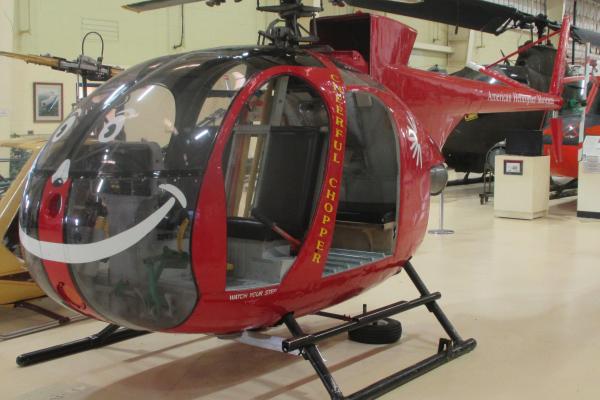
First Flight: February 27, 1963
Data from Jane’s Encyclopedia of Aviation, except for “Engine,” which is taken from the exhibit aircraft name plate.
In 1960 the U. S. Department of Defense issued Technical Specification 153 for an LOH (Light Observation Helicopter) capable of performing a variety of tasks that ordinarily would require the deployment of different types of aircraft. These tasks included personnel or cargo transport, light ground attack, and casualty evacuation, in addition to observation and photographic reconnaissance.
The Hughes Tool Company designed the Hughes Model 369, based on the Model 269, to meet these specifications. It received the revised military designation OH‑6 in July 1962. On February 27, 1963, the first OH‑6 (N9696F) made its maiden flight, and US Army trials began at Fort Rucker in Alabama the following November.
Because of its semi-monocoque construction, aerodynamic shape (it was nicknamed the “flying egg”), and compactness, the OH‑6A was easy to build, fly, and maintain. It could carry 2 pilots and 4 fully equipped troops or 950 lbs of cargo internally. The maximum external sling load is 1,350 lbs. Avionics included ADF, a track indicator, and VHF and LIHF transceivers. A wide choice of weapons was available. Kit type ordnance, which is attached to the cabin sides, included an XM‑75 grenade launcher or an XM‑27 or XM‑27‑E‑1 machine gun pod with 2000 rounds of ammunition. The gun pods could be pivoted through 90 degrees to fire forward or at intermediate downward angles.
The US Army selected the OH-6A as the winner of the LOH competition on May 26, 1965. Rather than all of these features, it was the lower cost that beat out the other options. The Army initially ordered 714 helicopters, a quantity later increased to 1,300 with an option for an additional 114. Delivery started in September 1966 and was due for completion by early 1969, with an anticipated eventual requirement of more than 4,000 aircraft. But cost over‑runs, along with production delays, caused the U. S. Army to reopen the design competition in 1967, with only 1,434 aircraft on order. Hughes delivered the last of these in August 1970. Bell won the re‑competition with the OH‑58 Kiowa, a spin‑off of the well‑known Bell Jet‑Ranger.
The Cayuse set 23 world records in the 1960’s, including a 2,213 mile non‑stop flight from California to Florida, a sustained altitude record of 28,218 feet, and a speed record of 172 mph.
The aircraft on display at the Museum is nicknamed “Cheerful Chopper.” It is featured in an animated film shown in our theater and in a children’s book, Cheerful Chopper to the Rescue, available in our Museum Store.
| Aircraft Specifications | |
|---|---|
| Rotor Diameter | 26 ft 4 in |
| Fuselage Length | 23 ft |
| Maximum Speed | 172 mph |
| Cruise Speed | 150 mph |
| Height | 8 ft 2 in |
| Gross Weight | 2,700 lbs |
| Engine | 317 shp Allison 250 C-18 |
This aircraft is available for “adoption” in the Museum’s Adopt-a-Copter program.